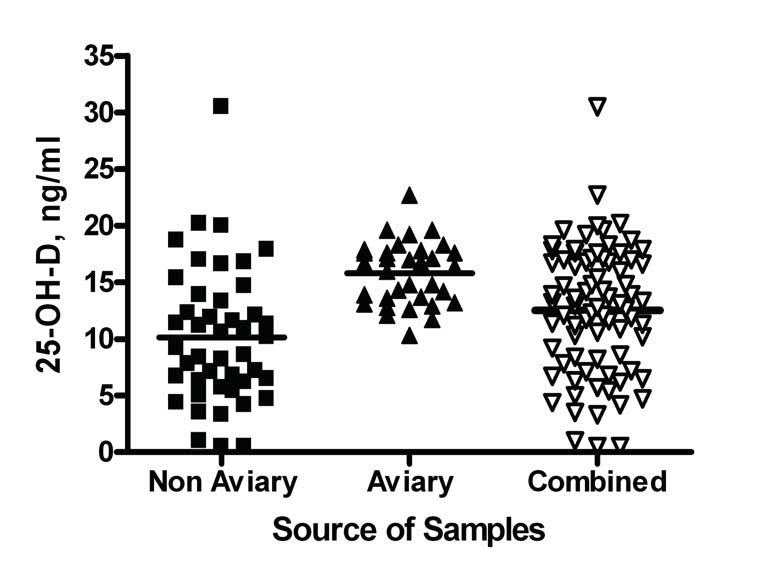Fern Van Sant, DVM, Carolyn Cray, PhD, Susan Clubb, DVM, Mary Siri, DVM, and Julie Young
Session #410
Summary Style Manuscript
Affiliation: From For the Birds, 1136 South De Anza Boulevard, Suite D, San Jose, CA 95129, USA (Van Sant, Young), University of Miami Miller School of Medicine Division of Comparative Pathology, 1600 NW 10th Avenue, Miami, FL 33136, USA (Cray), Rainforest Clinic, 3319 E Road, Loxahatchee, FL 33470, USA (Clubb), and Aptos Creekside Veterinary Hospital, 10404 Soquel Drive, Aptos, CA 95003, USA (Siri).
Human medical literature reflects the finding that low vitamin D levels have been linked to several chronic diseases in humans.1–3 Although optimal vitamin D3 levels have been well defined in poultry science,4 little is known about these values in pet birds. A 2006 study investigated calcium and vitamin D3 levels in African grey parrots (Psittacus erithacus) fed either a seed or formulated diet and exposed to artificial ultraviolet radia- tion. This study also investigated calcium and vitamin D3 levels in Pionus parrots exposed to natural sunlight.5 However, there is still much to learn about the relationship between vitamin D3 levels, total calcium, ionized calcium, and health in pet birds.
This study measured the 25-hydroxycholecalciferol (the active metabolite of vitamin D3) levels in 81 psittacine birds. Thirty-three samples were measured from an avicultural collection of African grey parrots, and 45 samples came from pet birds representing a number of different species. Participants selected for the study were deemed to be in good health at the time of blood collection. A commercially available DiaSorin radioimmunoassay test kit (Diasorin, Stillwater, MN, USA) was used for vitamin D3 analysis. Blood samples from the 45 pet birds were also submitted for total calcium, ionized calcium, and complete blood counts.
Results are presented in a scatter plot (Figure 1).

Figure 1. Concentrations of 25-hydroxycholecalciferol (25-OH-D), the active metabolite of vitamin D3, in 81 psittacine birds. Measurements were obtained from an avicultural collection (African grey parrots, n = 33) and multiple species not from the aviary collection (n = 45). Results plotted for aviary, “non-aviary,” and both combined.
References
1. Bikle D. Nonclassic actions of vitamin D. J Clin Endocrinol Metab. 2009;94:26–34.
2. Heaney RH. Vitamin D and calcium interactions: functional outcomes. Am J Clin Nutr. 2008;88(2): 541S–544S.
3. Moyad MA. Vitamin D: a rapid review. Urol Nurs. 2008;28(5):343–349.
4. Atencio A, Edwards HM, Pesti GM, Ware GO. The vitamin D3 requirement of broiler breeders. Poult Sci. 2006;85:674–692.
5. Stanford M. Effects of UVB radiation on calcium metabolism in psittacine birds. Vet Rec. 2006;159(8): 236–241.
